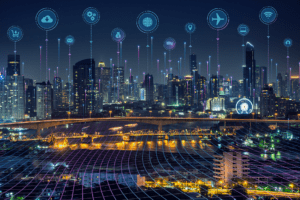Good decision-making relies on good information.
That’s why data collection is so important to businesses of all types. In healthcare, it can literally be a life-and-death concern. Currently, two data-related trends are delivering new levels of optimization in hospitals with the potential to vastly improve operations and safety:
- The convergence of information technology (IT) systems with operational technology (OT), which combines operational processes, insights, and controls into a unified environment.
- Internet of Things (IoT) implementations that drive automation and operational efficiencies, and widen visibility across the environment.
Real time, real results
In a hospital, IT/OT integration enables medical devices to exchange and share patient information through IoT connections for real-time visibility, resulting in better patient analysis and outcomes. Intel estimates that almost a third of smart devices currently in the market are in healthcare buildings.
This explains why the branch of the IoT that supports healthcare is increasingly known as the Internet of Medical Things (IoMT). It links and captures data from devices such as online pulse oximeters, heartrate monitors and insulin pumps.
The implementation of these devices to remotely monitor patients with diabetes, heart disease, asthma, and other conditions has created significant demand for IoMT solutions. The same is true of connected fitness and wellness devices.
The Internet of Medical Things (IoMT) market estimated to be worth $158.1 billion in 2022 according to Deloitte. With this significant market growth of IoMT, healthcare providers will need to figure out how to best incorporate these smart devices in their operations and workflow.
Meaningful KPIs
In an increasingly connected world, healthcare administrations constantly evaluate how to leverage the IoT in other areas besides remote monitoring to derive benefits in cost, performance and productivity. For instance, integrated data produced by IoT systems helps generate more accurate and meaningful KPIs that can accelerate efficiencies and boost performance organization-wide.
Access to real-time data and KPIs enables workflow optimization and quicker adaptation to market changes. In some cases, companies may be able to shed redundant systems so they can operate more efficiently and reduce costs.
At Schneider Electric, we’re committed to supporting this market with initiatives such as the Executive Briefing Center (IEBC) in St. Louis, where we showcase technologies through an immersive experience to build the hospital of the future.
These technologies can increase patient satisfaction by allowing them to take control of their own healthcare experience. They also enable clinical staff to focus on delivering better coordinated care.
Healthcare growing pains
While IoT promises to deliver significant benefits to healthcare, it requires setting the right strategy. And that includes addressing issues such as the IoT perception gap. Too often, people view IoT strictly as an IT discussion.
This is partly because IT and OT teams operate in separate silos. To change this perception, organizations need to treat IT/OT convergence not just as a merger of technologies, but also of people. This will take a culture change and a mutual understanding of the challenges brought on by a new endeavor.
Organizations also must address budget concerns. A Guidehouse Insights report found that concerns related to cost and return on investment (ROI) were the top two barriers to IoT implementations. But it’s important to understand that an integrated IoT platform can offer more than just operational savings. It can transform patient and staff experience, boost resilience, and address environmental, social, and corporate governance (ESG) directives.
At a practical level, IoT-powered intelligent patient solutions can give patients better control over their environmental preferences and easier access to care information such as doctor’s appointments. IoT also enables the creation of environments that are more responsive to patients and staff.
The backbone of smart healthcare
In many ways, IoT allows industries to stay ahead of the curve and remain resilient in the booming digital era. For hospitals, it’s about direct control, better patient monitoring, and easier data analysis from anywhere in the world.
Before IoT and IT/OT convergence, patients’ touch points with doctors were limited to in-person visits, phone calls and texting. Now providers can stay continuously connected to patients to monitor their health and react when necessary. Thanks to connectivity and data collection, medical professionals can do their jobs more efficiently and make critical calls that in some cases can save a life.
Access IoT and healthcare research report
Learn more about IoT solutions for healthcare be accessing “Global Insights: The IoT and the Future of Healthcare.” This Guidehouse Insights research report, commissioned by Schneider Electric, highlights IoT market trends and how IoT platforms can improved operational efficiency and resiliency resulting in improved patient satisfaction.



